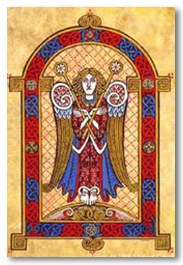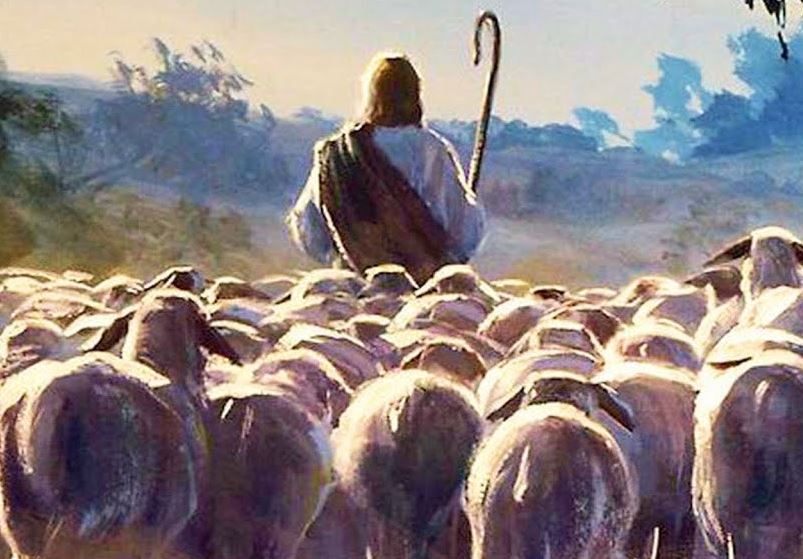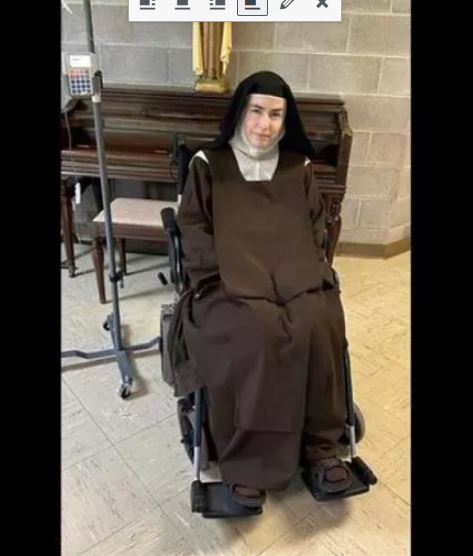One of the nicest surprises of living around the year with the Church is to find that Halloween is part of it.
Not that the Mass of the day has mention of black cats, or the Divine Office of witches, but for so long Halloween meant nothing but parties and vandalism that when someone first proposed that it came out of the liturgy, I asked: “Are you sure?”
You still hear people doubt it, even when you show them that Halloween is All-Hallows’-Eve which is the night-before-All-Saints’- Day. Some tell me they understand that Halloween pranks were a post-Reformation contribution to plague Catholics who kept the vigil of All Saints. Now it is possible that Halloween was abused for such a purpose; nevertheless, during all the Christian centuries up until the simplification of the Church calendar in 1956, it was a liturgical vigil in its own right and thus has a reason for being. Learning this, one pious lady of our acquaintance was heard to say: “Oh, I’m so glad to know that. I was about to write my congressman and suggest the whole thing be outlawed.”
A celebration much like our Halloween, with bonfires and feasting on apples and nuts and harvest fruits, was part of pagan worship for centuries. The Britons celebrated in honor of their sun-god with bonfires, a tribute to the light that brought them abundant harvest. At the same time they saluted Samhain, their “lord of death,” who was thought to gather together at last the souls of the year’s dead which had been consigned to the bodies of animals in punishment for their sins. The Romans celebrated the same kind of festival at this time in honor of their goddess Pomona, a patroness of fruits and gardens. Whether the Church “baptized” these customs or chose this season for her feasts of the dead independent of them, their coincidence shows again how alike men are when they seek God and His ways, give praise, use the language of symbols to express the inexpressible.
It was in the eighth century that the Church appointed a special date for the feast of All Saints, followed by a day in honor of her soon-to-be saints, the feast of All Souls. She chose this time of year, it is supposed, because in her part of the world it was the time of barrenness on the earth. The harvest was in, the summer done, the world brown and drab and mindful of death. Snow had not yet descended to comfort and hide the bony trees or blackened fields; so with little effort man could look about and see a meditation on death and life hereafter.
Apparently how you spent the vigil of All Saints depended on where you lived in Christendom. In Brittany the night was solemn and without a trace of merriment. On their “night of the dead” and for forty-eight hours thereafter, the Bretons believed the poor souls were liberated from Purgatory and were free to visit their old homes. The vigil for the souls, as well as the saints, had to be kept on this night because of course the two days were consecutive feasts and a vigil is never kept on a feast.
Breton families prayed by their beloveds’ graves during the day, attended church for “black vespers” in the evening and in some parishes proceeded thence to the charnel house in the cemetery to pray by the bones of those not yet buried or for whom no room could be found in the cemetery. Here they sang hymns to call on all Christians to pray for the dead and, speaking for the dead, they asked prayers and more prayers.
Late in the evening in the country parishes, after supper was over, the housewives would spread a clean cloth on the table, set out pancakes, curds, and cider. And after the fire was banked and chairs set round the table for the returning loved ones, the family would recite the De Profundis (Psalm 129) again and go to bed. During the night a townsman would go about the streets ringing a bell to warn them that it was unwise to roam abroad at the time of returning souls.
It was in Ireland and Scotland and England that All Hallows’ Eve became a combination of prayer and merriment. Following the break with the Holy See, Queen Elizabeth forbade all observances connected with All Souls’ Day. In spite of her laws, however, customs survived; even Shakespeare in his Two Gentlemen of Verona has Speed tell Valentine that he knows he is in love because he has learned to speak “puling like a beggar at Hallowmas.” This line must have escaped the Queen.
Tricks or treats old style
Begging at the door grew from an ancient English custom of knocking at doors to beg for a “soul cake” in return for which the beggars promised to pray for the dead of the household. Soul cakes, a form of shortbread and sometimes quite fancy, with currants for eyes became more important for the beggars than prayers for the dead, it is said. Florence Berger tells in her Cooking for Christ a legend of a zealous cook who vowed she would invent soul cakes to remind them of eternity at every bite. So she cut a hole in the middle and dropped it in hot fat, and lo a doughnut. Circle that it is, it suggests the never-ending of eternity. Truth or legend, it serves a good purpose at Halloween.
The refrains sung at the door varied from “a soul cake, a soul cake, have mercy on all Christian souls for a soul cake,” to the later:
Soul, soul, an apple or two,
If you haven’t an apple, a pear will do,
One for Peter, two for Paul,
Three for the Man Who made us all.
Here they had either run out of soul cakes or plain didn’t care. Charades, pantomimes, and little dramas, popular remnants of the miracle and morality plays of the Middle Ages, commonly rehearsed the folk in the reality of life after death and the means to attain it. It is probably from these that the custom of masquerading on Halloween had its beginning. The folly of a life of selfishness would be the message pantomimed by the damned; the torment of waiting, the message of the souls from Purgatory; the delights of the beatific vision, the message of the Heaven-sent. Together they warned the living to heed the means of salvation before it was too late. Doubtless the presence of goblins and witches with cats (ancient symbols of the devil) were remnants of pagan times bespeaking to Christians of spirits loosed from hell to keep track of their own and herd them back at cockcrow. Saint- Saens’ Danse Macabre with death fiddling his eerie spell over the graveyard fascinated us all the years of growing up. Waiting for the sound of cockcrow, which would send the souls scuttling back to their graves, was almost too much suspense to bear. Little did we know that it was inspired by old French customs and superstitions on All Hallows’ Eve.
The familiar harvest fruits, cornstalks, and pumpkins were seasonal. Although there is an old Irish legend about a miser named Jack who was too stingy to go to Heaven and too clever to go to hell, so that he had to spend eternity roaming the earth with a lighted pumpkin for a lantern, the appearance of jack-o’-lanterns has always seemed much more reasonable than that. These were ages when death was a serious and acceptable meditation. Christian art shows skulls and bones as a commonplace of interior decoration, at least in the cells of the convents and monasteries. Vigils were kept by the graves, and lights and bread left for the dead, all for the twofold purpose of recalling those dead and remembering that one day you would be dead. Surely it was some bright boy, stumbling over a pile of pumpkins by his father’s barn, who hit on the notion of carving a grinning death’s-head to carry, lighted by a candle, under his arm. If you know small boys, this is the most reasonable of all explanations.
Prayers and party fun together
Our family’s Halloween parties are now planned around the custom of begging for soul cakes. Among the neighborhood children who attend, Catholics together with non-Catholics, there is no one who is not intrigued to learn the stories of these customs and join in the prayers and the fun.
Frying doughnuts is a big undertaking, but this one time of the year we have a doughnut session the day before Halloween. Soul cakes need not be doughnuts, but we like to tell Mrs. Berger’s story; and this, of course, leads to much tasting to see if one does think of eternity at every bite. Other refreshments for the party are natural sweets apples, nuts, popcorn all perfect companions to the soul cakes.
Next, costumes. Saint costumes have been much in vogue in our circle since the rediscovery of Christian Halloween. These are lots of fun to make, but if you are having non-Catholic children who do not know about patron saints, a full course on the subject is not possible before the party. You might suggest that these come as some departed soul, one of those from eternity who come to warn the living to mend their ways. This gives much leeway and justifies the inevitable cowboys and space cadets. Cowboys do eventually depart, I am confident, and space cadets look as though they already have.
A rhymed invitation tells everybody that this is a real party and also keeps enough of the familiar Halloween ghostliness to enhance the rest, which sounds a little unfamiliar. Our invitation goes like this:
Come to keep vigil on All Hallows’ Even,
With Monica, Jamie, Peter and Stephen,
With John, Philip, Christopher, dressed up like souls;
Bring berries of red to help warn off the ghouls.
Come knock at the door and beg for soul cakes,
Pray hard for the souls, for the prayers that it takes<
To speed them to Heav’n go too often unsaid, Band who prays for poor souls will ne’er want for bread.
This hints at what is going to happen. Followed by a telephone call or a note to the mothers of the guests, it gives everyone time to get the “feel of it.” This is important. If it isn’t clearly explained how they will beg at the door and say a prayer for the dead, the party will disintegrate right there with the “gimmes.”
The berries of red and their use have their origin ‘way back when holly and evergreens bearing red berries were used to remind the Christians of the blood of Christ and the burning love of Mary for her Child. It is not hard for country children to find a spray of red berries, but even in the city there is bittersweet on sale at the street corner; or if you live near a barberry hedge, you might prevail on the owner to let you have a sprig and to show your good will tell him that it is a wise way to ward off witches.
An old witch patrols the lawn at our house this night, riding a broomstick and fleeing in fright from the groups of guests, terrified at the sight of the berries. Barred from the house by these berries (some of which are combined with autumn leaves and fastened to the front door in a swag), she has to be content to hoot and screech, pop out from behind trees; and when the time comes, bade by what she knows is the truth, she gives directions for begging at the door.
“I am forced to tell ye this, miserable dearies, whether I would or no; so mark it well. If ye pray for the dead, they are released sooner from their torment of waiting in Purgatory and sped on the wings of light to their eternal reward. So go and knock and the woman will open to your knock, and sing as loud as ye can: ‘A soul cake, a soul cake, a prayer for a soul cake!’ She will bear on her arm a basket of cakes and tell ye for whom ye are to pray. And may ye all choke on every crumb and find praying and eating at one and the same time as miserable as the torment I endure forever riding hungry on my broomstick!”
Everyone is delighted by her useless malice, and finds that simultaneous praying and eating is not difficult. Better yet, bade by the woman of the house, they pray before they eat (much more respectful). They pray for grandfathers and grandmothers and aunts and uncles and cousins and friends and all the souls in Purgatory. The Catholic children and the non-Catholic children say together for their dead the one prayer they share in common, the Our Father; and after the voices of the Catholic children have died away, the rest continue with “for thine is the kingdom and the power and the glory forever.” This, incidentally, was appended to the Our Father long before the so-called Reformation; it is one of those liturgical additions that was eventually dropped for the sake of purity. Knowing this helps eliminate some of the irritation Catholics feel when hearing it. It is not something the Protestants dreamed up just to be difficult.
Around the house to the various doors (because we live in the country we must confine our party to one house), and then inside for the celebration. In the city, children could go to several houses close together, or to several apartment doors. The old witch, spying one door without red berries, makes a last appearance cackling and greeting the guests from behind the puppet show. She shakes the children’s hands with a wet glove and presses an ice cube in each unsuspecting palm, whereupon they shriek and scream and pile through the door into the living room to duck for apples, chase them on strings, eat popcorn and soul cakes, and drink cider.
If there are many small children, plan the party for them and let the older children help give it. If there are more older children, it is best to plan the party for them. Sometimes it will work both ways, but more often than not, widely divergent age groups do not combine successfully for parties because the same games and entertainments do not appeal to both. If you have both small fry and older children, you might plan with the mothers of the neighborhood to hold two parties one for little children at one house, one for older children at another.
For very small children, ducking for apples, apples on strings, refreshments, the chance to make noise and antics in their costumes, can be nicely gathered up and rounded off by reading one or two stories. If they have come in saint costumes, the outstanding game can be telling your saint’s story after the others have guessed who you are.
For older children or even adults, “A Trayful of Saints” is a good game. On a tray place a dozen or more objects that symbolize familiar saints. For example: key St. Peter; flower Little Flower; rose St. Rose of Lima; dog St. Dominic; bird St. Francis of Assisi; cross St. Helena; crown St. Elizabeth of Hungary; eagle St. John the Evangelist; shell St. James; Sacred Heart St. Margaret Mary Alacoque; kitchen utensil St. Martha; half coat (paper cut-out) St. Martin of Tours. Go slowly from one guest to another, giving them time to memorize what is on the tray. Then pass out paper and pencils and have them list what they remember, and what saint they think they symbolize.
Charades depicting outstanding events in the lives of the saints are always fun at such a party, and ghost stories are in order when the apple ducking is done and people are sitting around the fire. Here is one for the little ones who may not be quite ready for those of the grimmer sort. This one is told by Granny Newland and it is true, about a Jack Doyle who lived with his grandmother in Antrim, which is where St. Kevin’s well is with the two hollows in the stone from where he rested his elbows at prayer, and they were forever after filled with water. Many’s the time she went as a child and tried to dry them out but the water was back in a wink.
Anyway, Jack lived with his grandmother, who was always growling because he came in so late at night. This night he was late again and hurrying home past the Blind Piers, where it was said there was always a ghost with blinking lights (but that’s another story). So he began to get nervous. He started to run and when he started to run he heard a noise right behind him. He ran faster and the faster he ran, the louder the noise behind him, until finally he reached his grandmother’s house in such a sweat it was rolling off him in great drops, and he fell in the kitchen over the half-door. His grandmother was sitting on a low stool in front of the fire saying her beads and she began to cross herself and call on all the saints and angels and the Blessed Mother of God to come to her protection. When Jack explained why he was in such a fit she gave a look and thought a thought, what do you think it was?
The stiff buckram lining in his brand-new coat.






 Newland, Mary Reed “All Hallows’ Eve” Chapter 19 in The Year and Our Children (P.J. Kenedy and Sons, 1956): 270-278.
Newland, Mary Reed “All Hallows’ Eve” Chapter 19 in The Year and Our Children (P.J. Kenedy and Sons, 1956): 270-278.
 Mary Reed Newland was a wife, mother of seven, artist, social advocate, storyteller, gourmet cook, and biographer of saints. She wrote many books, including
Mary Reed Newland was a wife, mother of seven, artist, social advocate, storyteller, gourmet cook, and biographer of saints. She wrote many books, including 

